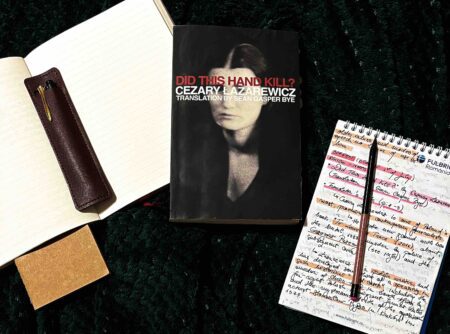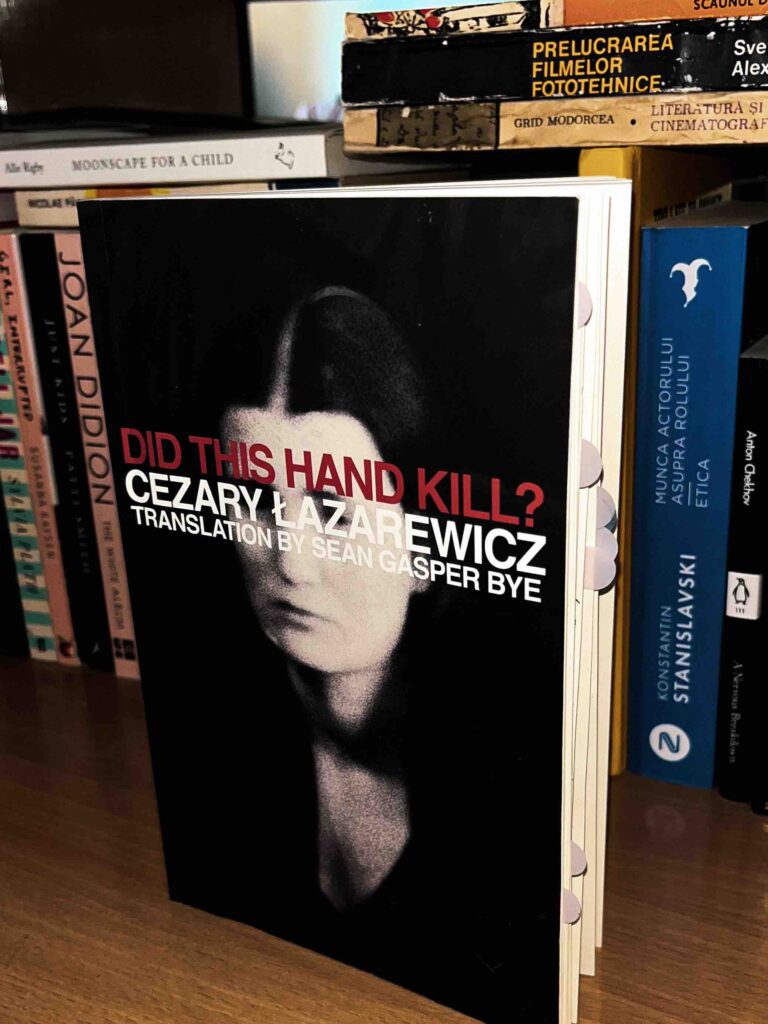Review: Did This Hand Kill?

| Author | Cezary Lazarewicz |
| Genre | Nonfiction: True Crime |
| Language(s) | English |
| Format | 264 Pages |
| Publisher | Open Letter Books |
| ISBN | 978-1-948830-79-9 |
| Photos by Jenny Graham | Mihaela-Adina Drăgan |
Reviewed by Mihaela-Adina Drăgan
Imagine standing in a courtroom, the air thick with tension, as an accused woman faces witnesses and the jury. This is the riveting story Cezary Łazarewicz unravels in his nonfiction book, Did This Hand Kill? (Open Letter, 2024), translated by Sean Gasper Bye.
This is an enthralling exploration divided into two distinct parts: The first part meticulously reconstructs the dramatic events that transpired in the villa at Brzuchowice, near Lviv, Poland, on the nights of December 30–31, 1931. Łazarewicz delves into the ensuing trial and the widespread social and media frenzy that accompanied it. The second part of the book ventures into the shadowy aftermath of the accused governess, Margarita Emilia Gorgonowa, and how her life after 1939 unfolded. The haunting question remains: Was Gorgonowa justly convicted? Is justice even possible?
Łazarewicz draws heavily from the case files, preserved in state archives, and from contemporary press reports, thus reconstructing the evidence proceedings and trials, including the witness statements and the arguments (of both prosecution and defense) with impeccable accuracy. Even without having perused the original files, one can sense the intricate craftsmanship of this 20th century judicial process, surprisingly akin to modern-day proceedings.
It is striking how the legal institutions and mechanisms today mirror those from that 1930s Poland, as we attempt to approach the truth of blurry events.
The author vividly captures the charged atmosphere surrounding the trial, the pervasive social and media hysteria, and the relentless pursuit of sensationalism. Journalists, especially when dealing with sensitive and emotionally charged topics, may be tempted to exaggerate or contribute to false narratives based solely on imagination or to keep readers engaged.
Łazarewicz presents this phenomenon well. He also shares alternative theories that surfaced during the trial, or emerged later. His portrayal of the Brzuchowice villa as a domestic hell is compelling, and complicates the case. He also takes his time to build the tension, from the moment when Henryk Zaremba finds out his daughter, Luisa, is dead, to the excruciating trial itself–and all the fear and guilt that came with it.
The second part of Łazarewicz’s narrative is a detective-like quest to piece together the wartime and post-war fate of Rita Gorgonowa from fragmented information. When discussing Rita, the author relies on the perspectives of those who knew her, leaving it to the readers to discern which psychological profiles resonate as truthful.
The author beautifully depicts the shift in Zaremba’s perspective as the lover of Rita. Initially, he viewed Gorgonowa as a savior and the perfect addition to their family. Over time, he grew to see her less as a nursemaid and more as the “Lady of the House” (Łazarewicz 71). Zaremba wrote how:
‘Her laugh filled the garden on that very first Sunday. She conquered the hearts of my
little ones. They took to her immediately. The children, hitherto shabby, began to look
cleaner. The positive impression she made grew week by week, month by month.’
(Łazarewicz 71)
Fast forward to the night of his daughter’s death and its aftermath, where he begins to view her with suspicion. He notices every change in her behavior, every detail out of place, any gesture that might seem lacking in empathy, and any ill-conceived remark she intended to be humorous. Łazarewicz recounts those moments on pages 19–20 with gorgeous detail:
Rita, whom Zaremba observes out of the corner of his eye, doesn’t come near the bed.
She’s wearing green slippers and a heavy, brown fur coat with a collar. ‘Must
you put on a fur coat when someone shouts ‘murder’?’“Henryk darling,’ she whispers in his ear. ‘I’m worried about you. Pull yourself together.
What’s done can’t be undone.’Henryk darling doesn’t reply.’

Adina Drăgan
Could it be that Gorgonowa was so accustomed to taking that coat and slippers when leaving her room that she did it instinctively? Was she the murderer? I suppose readers will never know for sure. That’s part of the appeal of this unsolved mystery–how do we approach the truth of gruesome misdeeds?
Łazarewicz’s strength lies in his ability to maintain a judicious distance, refraining from imposing his own views on the reader. He is thorough and persistent in his investigation, giving voice to all parties, including those with seemingly far-fetched theories. The narrative leaves readers grappling with a question that may never be answered, as time, war, and the fallibility of human memory shroud the truth. Reflecting on the final verdict, one might conclude that the court itself was left unconvinced of Gorgonowa’s guilt or innocence.
It is remarkable how, despite the motion of time, human nature remains constant while only the tools evolve. Today, the Gorgonowa case might dominate internet headlines, with spin-off content as social media reels, hot takes, podcast updates, and more.
But in the 1930s, newspapers were the main way information was dispensed, and sensationalized, which this book conveys well. Daily updates on the trial kept readers glued; it was entertainment for the public consumption, as well as a botched attempt at journalistic integrity, perhaps.
Written in accessible, vivid prose free from legal jargon, the book reads like a gripping crime novel despite being a factual report. Did This Hand Kill? is an outstanding act of reporting, undertaken so many years after the events and recovered from the aftermath, archival remnants of war, and is itself a testament to the author’s skill and dedication.

Mihaela-Adina Drăgan is a scriptwriter and aspiring filmmaker residing in Bucharest, Romania. Her writing is deeply intertwined with her emotions and experiences, drawing inspiration from her family, friends, and fleeting encounters with strangers who leave a lasting impression.
She primarily writes scripts, and she also has a passion for fiction and poetry. She recently received a bachelor’s degree in American Studies from Ovidius University of Constanța and is now a graduate student studying Society, Multimedia, and Spectacle at the University of Bucharest. To read more of her writing, visit https://substack.com/@adinadragan.
SUPPORT SEEFEST
Not a member yet? Become an art patron with other SEEfest arthouse aficionados in support of great events and programs. Our mission is to keep you informed about initiatives from our wide network of fellow cultural organizations.
We Welcome YOU!

